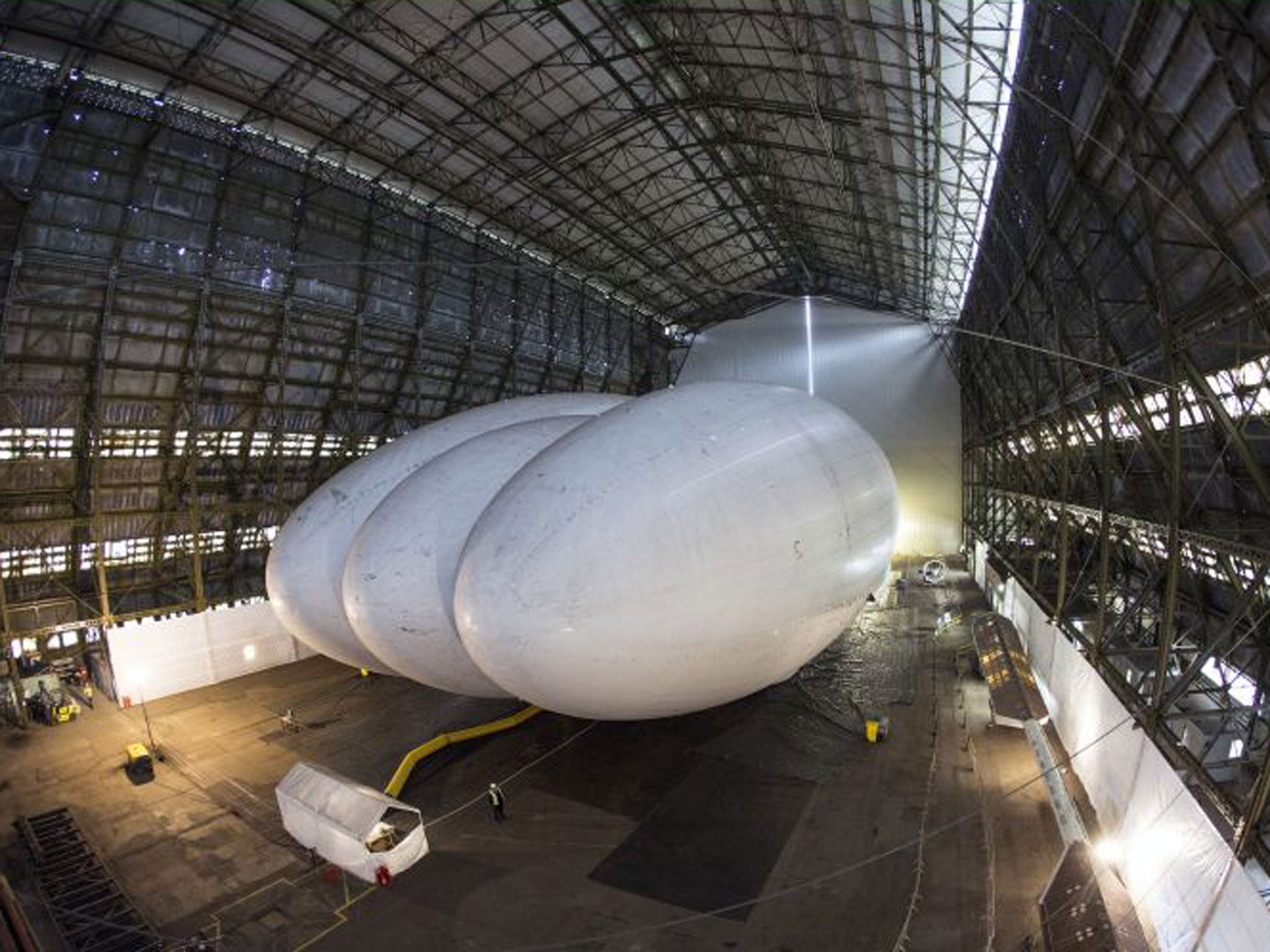Is it a bird? Is it a plane? No, it's the world's largest hybrid aircraft
The HAV304 or 'Airlander' is 300ft (91m) long, 113ft (34m) wide and 85ft (26m) high

The largest aircraft ever seen was launched today, as its British creators promised they could deliver up to 1,000 more and transform how the world responds to international disasters.
Sitting in the only "shed" in the country big enough to accommodate it – one of the two Cardington Hangers that dominate the Bedfordshire landscape – the 302ft (92m) Airlander is part plane, airship and helicopter. It can stay in the air for up to three weeks unmanned and is capable of touching down on land or sea.
Cranfield-based Hybrid Air Vehicles showed off their creation they said could also set a new benchmark for greener aircraft. Iron Maiden lead singer Bruce Dickinson, who is also a professional airline pilot and co-funded the Airlander, compared the £30m aircraft to Thunderbird 2 and declared it a momentous day in aviation history.
He said: “This is a beautiful thing – the sheer imagination and scale of it – British-designed and built. Rarely do you get the chance to be involved in something really at the cutting edge of aviation. We have created the world’s largest aircraft from a shed in Bedford. It is something to be incredibly proud of.”
The US Army was initially going to be the owners of the first HAV Airlander, to use primarily for surveillance missions in Afghanistan. But defence budget cuts meant the project was cancelled and HAV stepped in to bring the Airlander home and bring it to life.
The Airlander is about 60ft longer than the biggest airliners, the Airbus A380 and Boeing 747-8. It is also almost 30ft longer than the cargo-carrying Antonov An-225, which until now was the longest aircraft ever built.
Although resembling an airship with its giant helium-filled balloon on top of a 150ft long flight deck, the Airlander’s unique aerodynamic shape means it can generate lift like an aeroplane wing – and it’s going to get bigger. The prototype on display in Cardington is the forerunner of the Airlander 50, a 50-tonne heavy lift hybrid vehicle that should be in the air this time next year.
Dave Burns, the Airlander’s chief test pilot, gave The Independent a guided tour of the machine which from the rear looks like three giant cigars stitched together. “One of the problems with airships in the past has always been the ground handling with the number of people you need to manhandle it to keep it steady – the Airlander is the solution to that problem with its air cushioned landing system.
“The sheer mass of it makes it different to an airship, which are usually seven to eight tonnes. The Airlander is a 38-tonne machine so the inertia is incredible. Airships are like piloting an aircraft carrier in rough seas but this is very steady. It’s a majestic machine.”
HAV’s chief executive Stephen McGlennan said the plans to build up to 1,000 Airlanders in the coming decades could bring around 1,800 jobs to the area. The company has already had interest from governments and agencies all around the world.
“We want to building one Airlander a month in a few years’ time,” said Mr McGlennan. “Once they're built, they will get to work in places like Canada where they will be pivotal in operating remote mines for example or in the Middle East because of the large deserts they can operate in and master oil and gas pipelines.”
The Airlander project has just received a £2.5 million Government grant to fund research into energy efficient and quieter planes. Business Secretary Vince Cable said HAV is “a British SME that has the potential to lead the world in its field”.
Mr Dickinson said a chance meeting at a fundraiser for a movie project he was working on at the time with HAV’s founder Roger Munk, who died suddenly at the age of 62 in 2010, led him to become a key part of the project and put up the investment needed.
“I came here to a shed in about 2005 to see Roger and talk about the hybrid project,” said Mr Dickinson. “I had no idea I was ever going to see my money again but everyone has busted a gut and it’s brilliant to show it off to people today. In about five years’ time we could have a sustainable form of aviation – much cleaner and greener. You never know, someone like Amazon could be using one of these in the future as a one-stop shop in its supply chain.”
Join our commenting forum
Join thought-provoking conversations, follow other Independent readers and see their replies
Comments